
William Blake was an English poet, painter, and printmaker. Largely unrecognised during his life, Blake is now considered a seminal figure in the history of the poetry and visual art of the Romantic Age. What he called his "prophetic works" were said by 20th-century critic Northrop Frye to form "what is in proportion to its merits the least read body of poetry in the English language". While he lived in London his entire life, except for three years spent in Felpham, he produced a diverse and symbolically rich collection of works, which embraced the imagination as "the body of God", or "human existence itself".
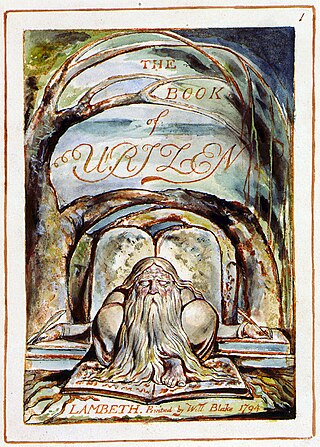
The Book of Urizen is one of the major prophetic books of the English writer William Blake, illustrated by Blake's own plates. It was originally published as The First Book of Urizen in 1794. Later editions dropped the "First". The book takes its name from the character Urizen in Blake's mythology, who represents alienated reason as the source of oppression. The book describes Urizen as the "primeaval priest" and narrates how he became separated from the other Eternals to create his own alienated and enslaving realm of religious dogma. Los and Enitharmon create a space within Urizen's fallen universe to give birth to their son Orc, the spirit of revolution and freedom.
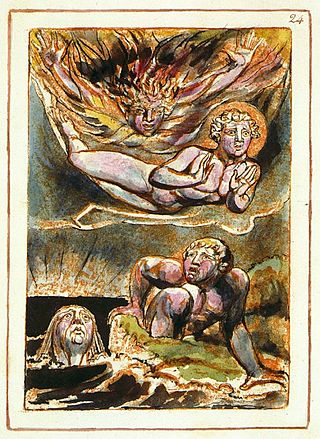
In the mythological writings of William Blake, Fuzon is the fourth and final son of Urizen, associated with the classical element of fire. In The Book of Ahania he fights Urizen for control of the world.

The prophetic books of the 18th-century English poet and artist William Blake are a series of lengthy, interrelated poetic works drawing upon Blake's own personal mythology. They have been described as forming "what is in proportion to its merits the least read body of poetry in the English language". While Blake worked as a commercial illustrator, these books were ones that he produced, with his own engravings, as an extended and largely private project.

The Spectre is one aspect of the fourfold nature of the human psyche along with Humanity, Emanation and Shadow that William Blake used to explore his spiritual mythology throughout his poetry and art. As one of Blake's elements of the psyche, Spectre takes on symbolic meaning when referred to throughout his poems. According to professor Joseph Hogan, "Spectre functions to define individuals from others [...] When it is separated [from Emanation], it is reason, trying to define everything in terms of unchanging essences." Thus, according to Samuel Foster Damon, Spectre epitomizes "Reason separated from humanity" and "Self-centered selfhood" or, as Alexander S. Gourlay puts it, Spectre is "characterized by self-defensive rationalization".
Tiriel is the eponymous character in a poem by William Blake written c.1789, and considered the first of his prophetic books. The character of Tiriel is often interpreted as a foreshadowing of Urizen, representative of conventionality and conformity, and one of the major characters in Blake's as yet unrealised mythological system.
Har is a character in the mythological writings of William Blake, who roughly corresponds to an aged Adam. His wife, Heva, corresponds to Eve. Har appears in Tiriel (1789) and The Song of Los (1795) and is briefly mentioned in The Book of Thel (1790) and Vala, or The Four Zoas (1796-1803).
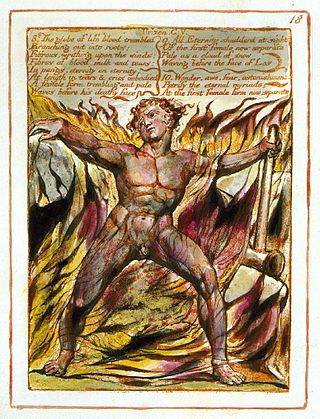
In the mythological writings of William Blake, Los is the fallen form of Urthona, one of the four Zoas, and the embodiment of human creativity and inspiration. He is referred to as the "eternal prophet" and creates the visionary city of Golgonooza. Los is regularly described as a smith, beating with his hammer on a forge, which is metaphorically connected to the beating of the human heart. The bellows of his forge are the human lungs. Los's emanation, Enitharmon, represents spiritual beauty and embodies pity, but at the same time creates the spatial aspect of the fallen world, weaving bodies for men and creating sexual strife through her insistence upon chastity. In the Book of Urizen (1794), Los and Enitharmon have a child, Orc, who is the embodiment of the spirit of revolution. The name Los is, by common critical acceptance, an anagram of Sol, the Latin word for "sun". Los is also the plural form of El, an ancient Hebrew deity. Such innovations are common in many of Blake's prophetic poems.
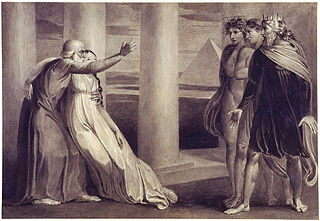
Tiriel is a narrative poem by William Blake, written c.1789. Considered the first of his prophetic books, it is also the first poem in which Blake used free septenaries, which he would go on to use in much of his later verse. Tiriel was unpublished during Blake's lifetime and remained so until 1874, when it appeared in William Michael Rossetti's Poetical Works of William Blake. Although Blake did not engrave the poem, he did make twelve sepia drawings to accompany the rough and unfinished manuscript, although three of them are considered lost as they have not been traced since 1863.

"Ah! Sun-flower" is an illustrated poem written by the English poet, painter and printmaker William Blake. It was published as part of his collection Songs of Experience in 1794. It is one of only four poems in Songs of Experience not found in the "Notebook".

Earth's Answer is a poem by William Blake within his larger collection called Songs of Innocence and of Experience. It is the response to the previous poem in The Songs of Experience-- Introduction . In the Introduction, the bard asks the Earth to wake up and claim ownership. In this poem, the feminine Earth responds.

Europe a Prophecy is a 1794 prophetic book by the British poet and illustrator William Blake. It is engraved on 18 plates, and survives in just nine known copies. It followed America a Prophecy of 1793.

Vala, or The Four Zoas is one of the uncompleted prophetic books by the English poet William Blake, begun in 1797. The eponymous main characters of the book are the Four Zoas, who were created by the fall of Albion in Blake's mythology. It consists of nine books, referred to as "nights". These outline the interactions of the Zoas, their fallen forms and their Emanations. Blake intended the book to be a summation of his mythic universe but, dissatisfied, he abandoned the effort in 1807, leaving the poem in a rough draft and its engraving unfinished. The text of the poem was first published, with only a small portion of the accompanying illustrations, in 1893, by the Irish poet W. B. Yeats and his collaborator, the English writer and poet Edwin John Ellis, in their three-volume book The Works of William Blake.

Nebuchadnezzar is a colour monotype print with additions in ink and watercolour portraying the Old Testament Babylonian king Nebuchadnezzar II by the English poet, painter, and printmaker William Blake. Taken from the Book of Daniel, the legend of Nebuchadnezzar tells of a ruler who through hubris lost his mind and was reduced to animalistic madness and eating "grass as oxen".

William Blake drew and painted illustrations for John Milton's nativity ode On the Morning of Christ's Nativity between 1803 and 1815. A total of 16 illustrations are extant: two sets of six watercolours each, and an additional four drawings in pencil.

The Book of Los is a 1795 prophetic book by the English poet and painter William Blake. It exists in only one copy, now held by The British Museum. The book is related to the Book of Urizen and to the Continental prophecies; it is essentially a retelling of Urizen from the point of view of Los. The book has been described as a rewriting of the ancient myth of creation that equates fall with the loss of spiritual vision brought about by selfhood.

Blake: Prophet Against Empire: A Poet's Interpretation of the History of His Own Times is a 1954 biography by David V. Erdman whose subject is the life and work of English poet and painter William Blake.
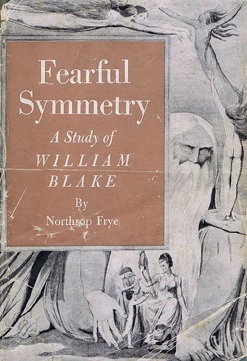
Fearful Symmetry: A Study of William Blake is a 1947 book by Canadian literary critic Northrop Frye whose subject is the work of English poet and visual artist William Blake. The book has been hailed as one of the most important contributions to the study of William Blake and one of the first that embarked on the interpretation of many of Blake's most obscure works. As Frye himself acknowledges, Blake's work is not to be deciphered but interpreted and seen within its specific historical and social contexts.
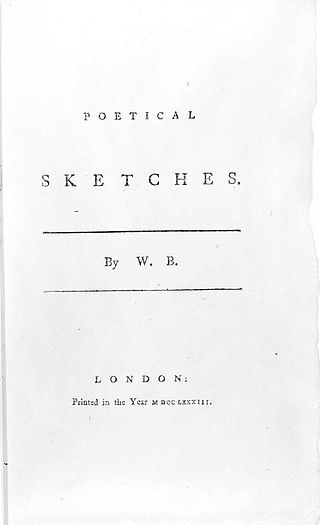
Poetical Sketches is the first collection of poetry and prose by William Blake, written between 1769 and 1777. Forty copies were printed in 1783 with the help of Blake's friends, the artist John Flaxman and the Reverend Anthony Stephen Mathew, at the request of his wife Harriet Mathew. The book was never published for the public, with copies instead given as gifts to friends of the author and other interested parties. Of the forty copies, fourteen were accounted for at the time of Geoffrey Keynes' census in 1921. A further eight copies had been discovered by the time of Keynes' The Complete Writings of William Blake in 1957. In March 2011, a previously unrecorded copy was sold at auction in London for £72,000.
The Collected Works of Northrop Frye is a uniform scholarly edition of the writings of the 20th-century literary critic Northrop Frye. The series was published by the University of Toronto Press under the general editorship of Alvin A. Lee, with the first of its thirty volumes appearing in 1996 and the last appearing in 2012. Alongside Frye's established critical writings, interviews, and speeches, the Collected Works presents previously unpublished material, such as diaries, book drafts, and juvenilia, drawn from his archives at Victoria University, Toronto. The project was funded by various grants from the Michael G. DeGroote family through McMaster University, from the Social Sciences and Humanities Research Council of Canada, and from Victoria University, Toronto.



















